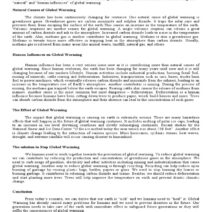Global warming is an existential challenge that poses a dire threat to our planet, ecosystems, and future generations. However, convincing someone that it is real can be a daunting task. Addressing skepticism requires a skillful blend of empathy, informed arguments, and effective communication strategies. Here are some comprehensive tips to facilitate productive conversations on global warming and shift perspectives.
1. Establish Common Ground
Begin your conversation by identifying shared values, such as a commitment to health, safety, and future prosperity. These principles resonate universally, regardless of political or ideological divides. When individuals comprehend that your concern for climate change stems from a desire for a healthier planet, they may be more receptive to your message.
2. Harness Personal Narratives
Data and statistics alone often fail to sway doubts. Instead, employ personal stories and anecdotal evidence. Share experiences that highlight the tangible effects of climate change in your community—unprecedented droughts, intense storms, or shifts in wildlife patterns. Personal narratives create an emotional connection that can make the issue more relatable.
3. Utilize Credible Sources
In a landscape rife with misinformation, relying on well-respected scientific bodies and peer-reviewed studies is essential. The Intergovernmental Panel on Climate Change (IPCC) and National Aeronautics and Space Administration (NASA) are reputable sources that provide data grounded in extensive research. When you cite such sources, it demonstrates a commitment to accuracy, bolstering your argument.
4. Address Misconceptions Head-On
Approach misconceptions gently, with the aim of fostering dialogue rather than confrontation. For example, if someone argues that climate change is merely a natural cycle, explain the current speed and scope of change, which far exceed historical norms. Understand the roots of their skepticism and respond with clarity and patience.
5. Illustrate the Economic Implications
Economic arguments can be particularly compelling. Present evidence that outlines the financial burden of inaction versus investment in sustainable practices. Discuss how renewable energy sources create jobs, reduce costs in the long term, and stabilize energy prices. Framing climate change as an economic issue rather than just an environmental concern can resonate deeply.
6. Foster an Inquisitive Atmosphere
Encourage curiosity by posing thought-provoking questions rather than delivering lectures. Ask them how they believe climate change will impact future generations or what steps they think should be taken to mitigate its effects. This method prompts self-reflection and allows for a more engaging exchange of ideas.
7. Highlight Local Effects
Global warming may seem abstract, but localizing the issue can offer a more tangible perspective. Discuss phenomena they may witness in their immediate environment, such as the decline of native species, changes in seasonal weather patterns, or the increasing frequency of natural disasters. Grounding the conversation in their reality helps elevate the seriousness of the issue.
8. Introduce the Concept of Cascading Effects
Climate change is not a standalone phenomenon; it has far-reaching effects that cascade through various systems—ecological, social, and economic. Explain how rising temperatures affect food security, health care costs, and social inequality. By illustrating interconnectedness, individuals can grasp the broader implications of climate change.
9. Discuss Low-Impact Solutions
When discussing solutions, emphasize practical, low-impact actions that anyone can undertake. Encourage small lifestyle changes—like reducing plastic use, conserving energy, or supporting local sustainability initiatives. When people perceive a feasible way to contribute, they may become more inclined to accept the reality of global warming.
10. Be Patient and Open-Minded
Change rarely occurs overnight. Provide a nurturing environment where doubts and questions can be expressed without judgment. Be prepared to revisit the conversation multiple times, gradually reinforcing your points. It’s important to remain approachable, as a dismissive attitude can alienate rather than unite.
11. Empathize with Their Concerns
Often, skepticism about global warming stems from fear—fear of loss, inconvenience, or economic instability. Acknowledge these feelings, and show understanding of the challenging implications of accepting climate change. Offering reassurance that collective action can lead to solutions helps alleviate apprehension.
12. Use Visual Aids
Visual representations can be extraordinarily effective in conveying complex data. Infographics, charts, photographs, and videos can create a visceral response that raw data cannot. These tools transform numbers into narratives, making it easier for individuals to grasp the severity of climate change.
Conclusion
Changing someone’s perspective on global warming requires empathy, informed dialogue, and patience. By establishing common ground, utilizing personal narratives, and addressing misconceptions, you can foster engaging conversations that lead to greater understanding. Remember, the goal is not to win an argument but to illuminate the topic and inspire curiosity about our planet’s future. Each conversation has the potential to influence another’s worldview, ultimately contributing to a broader movement toward climate action.








